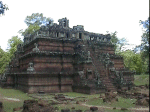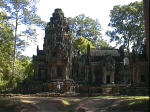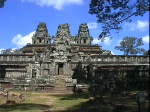Cambodia: Temples
Created | Updated Jun 21, 2003
The Baphuon
The Baphuon, like many of the Angkor temples, is a representation of the mythical Mt. Meru and so is pyramidal in shape.

It was built by Udayadityavarman II who reigned between 1049 and 1065 and was at the centre of the city that was on the site before the construction of Angkor Thom.
Currently there is major restoration work going on, and so it is only possible to see the temple from the causeway.
The Royal Enclosure And Phimeanakas
Another pyramidal representation of Mt. Meru; Phimeanakas means 'Celestial Palace'.

The temple is at the centre of a walled area that once housed the palace of Jayavarman V and Udayadityavarman I. While now most of the decoration has disappeared, an account by the Chinese envoy Zhou Daguan talks of a golden spire at the top of the temple.
The Thommanon Temple
The Thommanon temple is one of a pair of temples (the other is the Chau Say Tevoda) built during the second quarter of the twelfth century. Both were dedicated to Shiva and Vishnu and share a similar plan.
The temples are just east of the Victory Gate of Angkor Thom, the Chau Say Tevoda is south of the road and was being restored (slowly according to Hud) with support from the People's Republic of China. The Thommanon is to the north of the road.

Ta Keo
Ta Keo was built by Jayavarman V, who ruled between 968 and 1001. It was the first monument at Angkor to be constructed completely from sandstone. This may be the reason that the carvings on the especially hard sandstone were never completed.

Climbing the pyramidal temple is hot work, even early in the day; but it is worth it as one gets a better understanding of the massiveness of the Angkor temples after seeing the unfinished stonework. There is also a great view over the jungle from the top of the pyramid
Ta Prohm
Ta Prohm is the third of the major attractions of Angkor, although its appeal is controversial. It has been left to the jungle and so gives an impression of what the other temples were like when 'discovered' by the French. It has been described as:
'romanticism fuelled by spectacular effects'
but, for the romantic in you, I would recommend a visit.
Ta Prohm is made up of many narrow corridors and small courtyards; many impassable due to fallen masonry.
Walking around Ta Prohm it is hard not to be awe-struck by the power of the jungle, slowly enveloping and then tearing apart the works of man.
Banteay Kdei and the Sras Srang
Just south of Ta Prohm is the Banteay Kdei temple; another construction of Jayavarman VII's (recognisable by the entrances topped by the four faces of Avalokiteshvara).
The massive temple at the centre is surrounded by four concentric walls.
To the east of the Banteay Kdei is the Sras Srang, or Pool of Ablutions.
